Disclaimer
Please be advised that the following blog post contains images and descriptions of the raw meat trade, which may be disturbing to some readers. The pictures include explicit scenes from the mutton market, capturing the reality of the processes involved in meat preparation. Viewer discretion is advised, particularly for those with sensitivities to such content.
When it comes to mutton, a dish cherished by many worldwide, Hubli, a vibrant city in Karnataka, India, has carved out a special place for itself. Known for its distinct flavors and high-quality meat, Hubli’s mutton has caught the eye of food lovers and experts.
The centerpiece of this culinary delight is the Kalal National Mutton Market, the largest mutton market in the city, which stands alongside the equally famous fish market in Hubli, offering a rich variety of fresh produce to the locals.
Renowned for its quality produce, the mutton from Hubli boasts a distinct taste and texture, unlike anything you might have experienced. A delightful gastronomical journey into the world of mutton begins with understanding what makes Hubli’s mutton so special. Known for its exceptional tenderness and juiciness, Hubli’s mutton primarily comes from indigenous sheep breeds. Raised on the lush pastures around the city, these sheep feed on a variety of grasses, herbs, and shrubs, contributing to the unique flavor profile of the mutton.
Hubli Mutton Price Per Kg
As of 2024, the price of mutton in Hubli ranges around ₹750 to ₹800 per kilogram, a testament to the quality of meat available. The price may vary depending on the cuts and the quality of the meat, but rest assured, every rupee spent promises an unrivaled taste experience.
Now, let’s take a virtual tour of the Kalal National Mutton Market through a series of photos, providing a glimpse into the bustling heart of Hubli’s mutton trade.
Welcome to the Hub of Hubli’s Mutton Trade
As you step into this bustling Hubli Mutton Market – The Kalal National Mutton Market, you’re greeted by a sight that is typical, yet uniquely remarkable.
The first photograph captures this entrance scene, a vista of the first two shops which set the tone for what’s to come.

On display are rows upon rows of slaughtered and skinned sheep, hung meticulously on rods, catching the eye of every passerby. Freshly butchered, they glisten under the overhead lights, highlighting the superior quality of the meat available here.

The sight is raw and authentic, it does not shy away from the reality of the meat trade. Instead, it draws customers in with the promise of freshly procured mutton, brimming with potential for a multitude of delectable dishes.
This opening spectacle, stark and striking, is a testament to the market’s transparency and confidence in the quality of its produce. It sends a clear message to visitors – in the Kalal National Mutton Market, quality is paramount.
Artistry in Action: The Precision of Mutton Processing

The above image takes us deeper into the heart of the Kalal National Mutton Market. Here, we witness a sight that speaks volumes about the market’s skilled craftsmanship and diligent service.
Here as you see, a shop worker is engrossed in processing a customer’s order. His focus is intense as he skillfully wields a large, sharp knife, slicing through a mutton leg placed on a sturdy wooden block. Each stroke is precise, aimed at ensuring the perfect cut while preserving the meat’s integrity.
His methodical chopping strikes a rhythm, a soundtrack to the busy marketplace. The sight and sound combined create an atmosphere of professionalism and expertise. The photo captures not just a moment, but an ethos that reverberates through the market – the assurance of quality cuts, processed with skill and dedication.
This single frame encapsulates a day in the life of the market’s industrious workers, hinting at the hard work that goes into every kilogram of mutton sold, every meal that reaches a customer’s table.
The Initial Stages of Mutton Processing
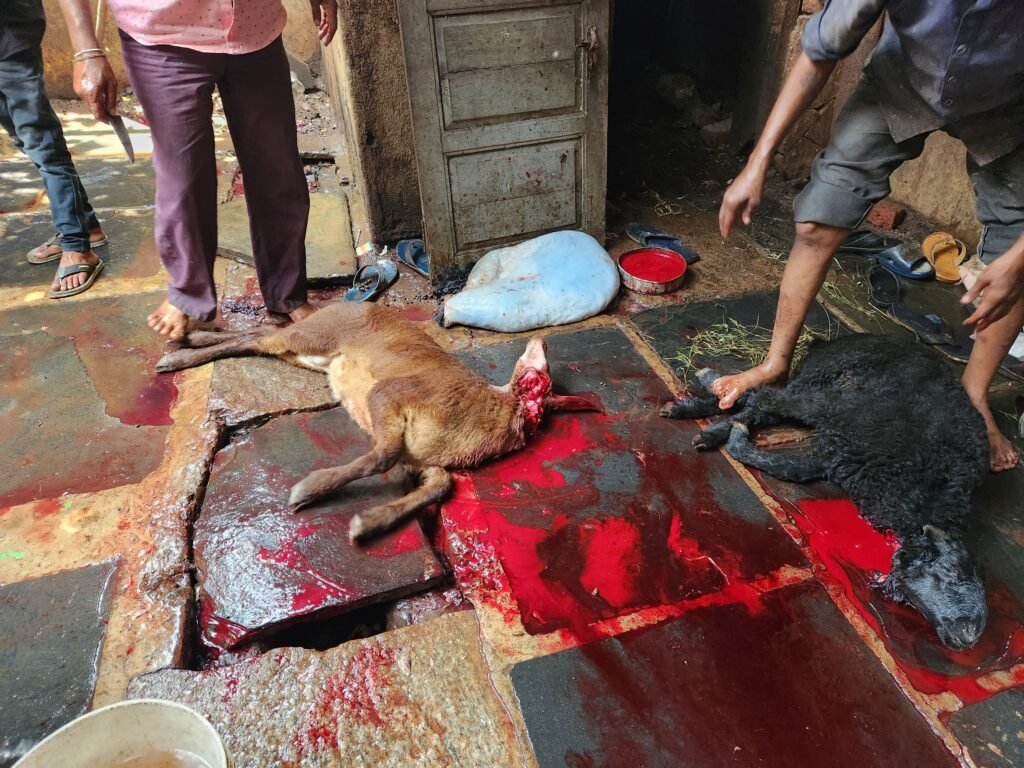
This starkly real snapshot presents two freshly slaughtered lambs, their necks half-slit, as part of the halal method of butchering.
It is a waiting game at this point. The butchers stand by, letting the blood drain away before the skinning process can begin. This is a critical step that ensures the mutton retains its unique flavor and tenderness.
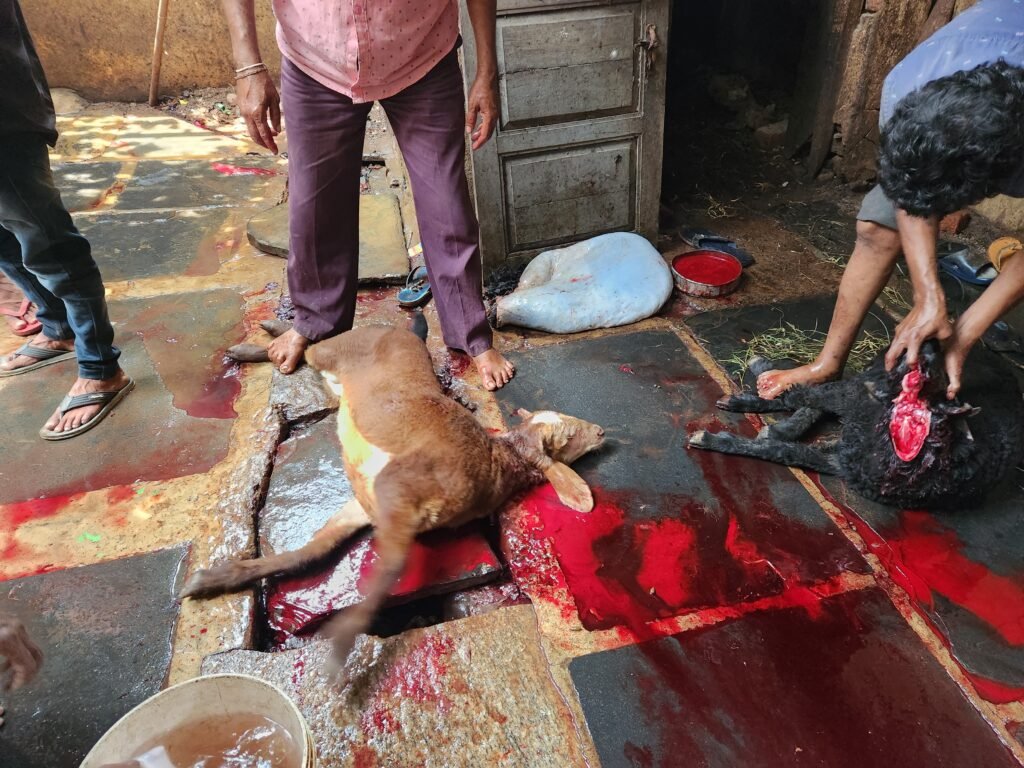
A notable detail in the photograph is the butcher’s foot placed firmly on the lamb’s feet. It’s a sight that can be initially disconcerting, but it reveals a practical necessity in this line of work: preventing the freshly slaughtered lamb from making erratic movements and causing a mess.
This image encapsulates the uncompromising realities of the meat trade, which can be raw and unsettling.
An Ode to Local Cuisine: The Unconventional Delicacies
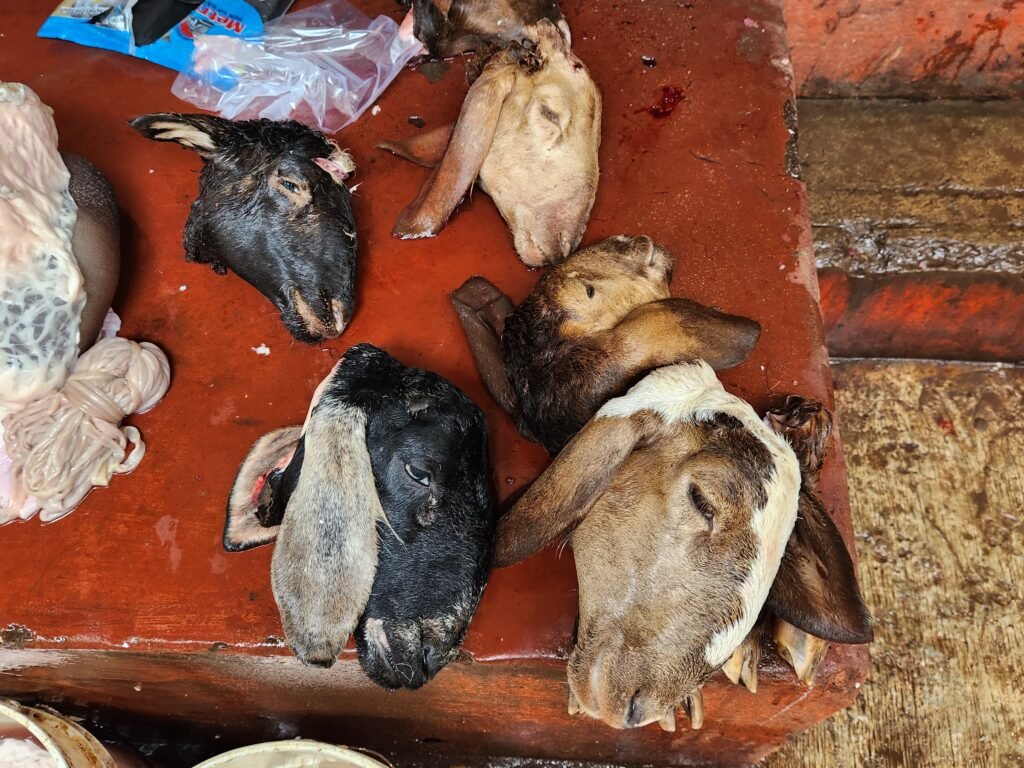
The next image introduces us to a local gastronomical feature that adds to the distinct character of the Kalal National Mutton Market. It portrays two sheep heads and several sheep feet displayed prominently at a vendor’s stall.
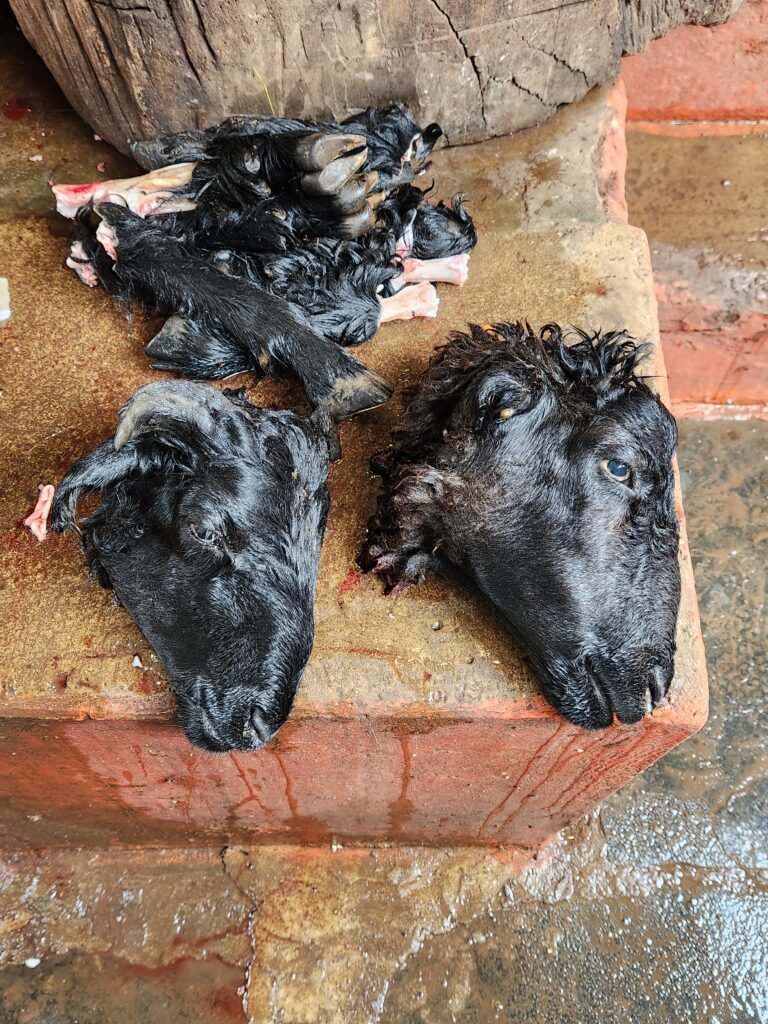
It might seem unusual to an outsider, but these are ingredients that hold a place of honor in the local cuisine. The sheep heads are purchased to prepare a local recipe called “Mundi Masala”, a popular dish that uses the unique flavors of the brain, tongue, and cheeks to create an aromatic and savory delicacy.
Similarly, the sheep feet displayed are destined to add richness and depth to dishes like “Paya Soup”. This traditional Indian soup is beloved for its collagen-rich broth and complex flavors, a testament to the use of every part of the animal in the local cuisine.
This image underscores the diversity of the mutton offerings at the market. Here, nothing goes to waste, and every part of the sheep finds its way into beloved recipes, enriching the culinary landscape of Hubli.
The Culinary Ritual: Preparing Sheep Heads for Local Delicacies
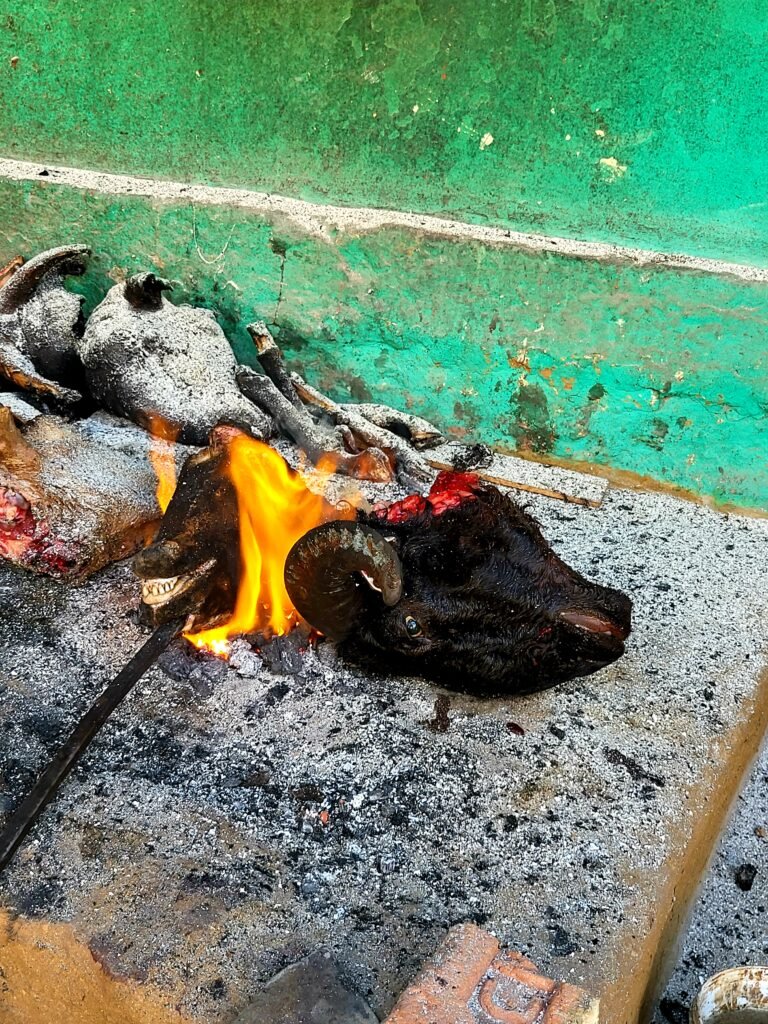
This image transports us to the outer premises of the Kalal National Mutton Market, where an essential process in the preparation of sheep heads takes place.
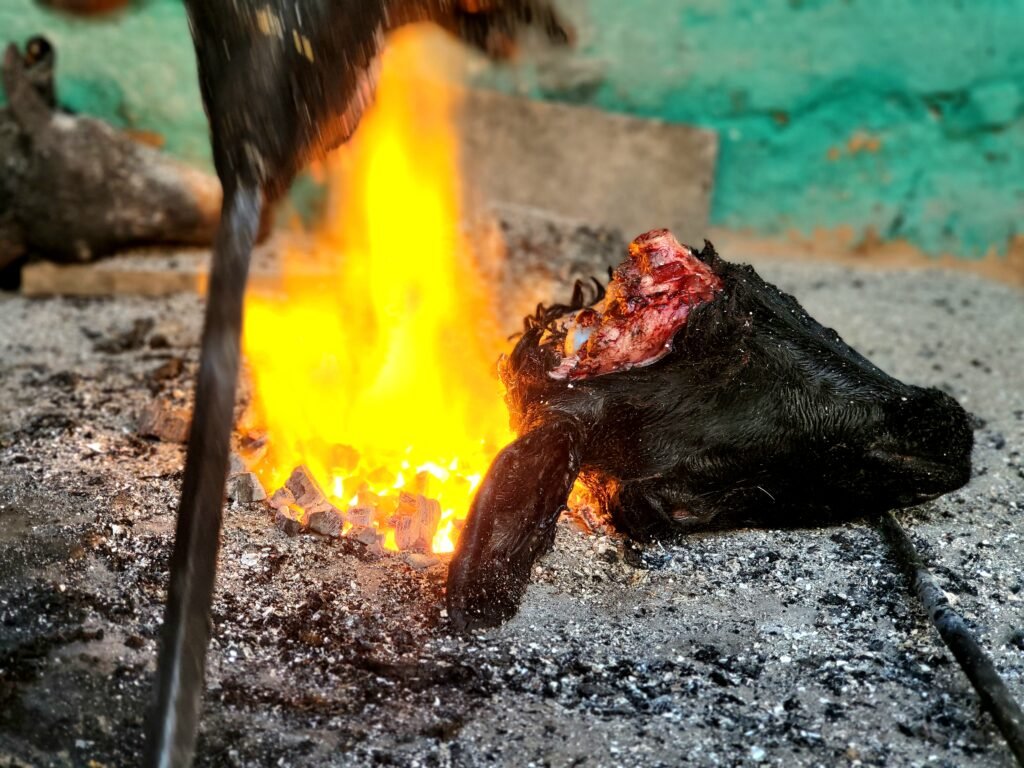
It’s a sight that has an almost ritualistic feel to it. The heads are subjected to an open flame that singes away the residual hair, preparing them for the next steps in their culinary journey. The fiery glow juxtaposed against the early evening backdrop paints a picture that is both surreal and deeply human.

Post the burning, the heads are thoroughly scrubbed and cleaned, ensuring no trace of burn or hair remains. The clean heads are then chopped into smaller pieces, ready to add depth and flavor to dishes like the aforementioned Mundi Masala.

This stage in the mutton processing pipeline might seem unconventional to the uninitiated, yet it forms a significant part of the culinary tradition in Hubli. It is this dedication to maintaining authenticity and attention to detail that sets the Kalal National Mutton Market apart.
Strength and Grace: Women in the Heart of Mutton Trade

This photograph features a woman worker at the market, poised and confident amidst the daily hubbub.
She sits next to rows of sheep legs lined up for the burning process. Just within the frame, you can also spot a single sheep’s horn, a subtle reminder of the market’s raw authenticity.
Her presence is a testament to the important role women play in the mutton trade, often overlooked in the narrative. Despite the physically demanding work and long hours, she exudes a quiet strength and grace that embodies the spirit of the Kalal National Mutton Market.
This image shines a light on the untold stories of the market, the people behind the scenes whose efforts and commitment ensure that Hubli’s mutton continues to be a culinary delight.
As our virtual journey through the Kalal National Mutton Market draws to a close, we’re left with a profound appreciation for the effort and dedication that goes into each step of the process. From the first display of high-quality mutton that greets you at the entrance, to the skillful butchering of the meat, to the unique preparation of local delicacies, every element of the market comes together in a resilient symphony of flavor and tradition.
The striking images serve as a window into this vibrant marketplace, providing glimpses into the hard work and commitment of the people behind the scenes.
Conclusion
The Kalal National Mutton Market, Hubli’s biggest mutton market, is more than just a marketplace. It is a testament to the city’s culinary heritage and the people’s dedication to maintaining the exceptional quality of their produce. As we’ve walked through the market via these images, we’ve witnessed the passion, tradition, and precision that goes into every kilogram of mutton sold. It’s an experience that reminds us of the story behind our meals, a story of hard work, culinary expertise, and above all, a love for good food.
It is this spirit that makes the Kalal National Mutton Market not just a place to buy mutton, but a destination that offers a culinary journey that enthralls the senses, a journey worth experiencing when you visit the vibrant city of Hubli.
Until our next exploration, keep your palates curious and your spirits high!














My god, the scenes are too much to handle. Im from Hubli only, but Ive never entered a mutton slqughter house.
Amazing journalism and you have covered the Hubli’s meat market scene so well with a totally different perspective. You should write for our newspaper. Ive reached you through the contact form, please check your email and revert with your thoughts.